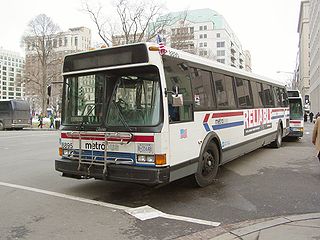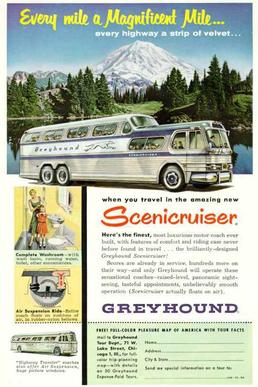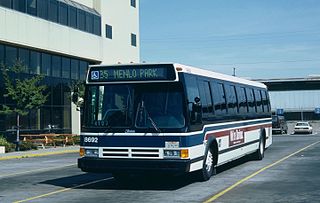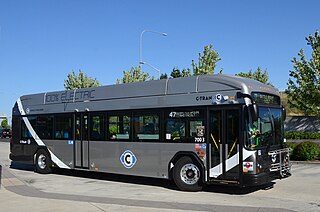
The Flxible Co. was an American manufacturer of motorcycle sidecars, funeral cars, ambulances, intercity coaches and transit buses, based in the U.S. state of Ohio. It was founded in 1913 and closed in 1996. The company's production transitioned from highway coaches and other products to transit buses over the period 1953–1970, and during the years that followed, Flxible was one of the largest transit-bus manufacturers in North America.

Motor Coach Industries (MCI) is a North American multinational bus manufacturer, specializing in production of motorcoaches. Best known for coaches produced for intercity transit and commuter buses, MCI produces coaches for a variety of applications, ranging from tour buses to prison buses.

Nova Bus is a Canadian transit bus manufacturer headquartered in Saint-Eustache, Quebec. Nova is owned by the Volvo Group.

Transportation Manufacturing Corporation (TMC) was a bus manufacturer based in Roswell, New Mexico.
The Yellow Coach Manufacturing Company was an early manufacturer of passenger buses in the United States. Between 1923 and 1943, Yellow Coach built transit buses, electric-powered trolley buses, and parlor coaches.

The GM New Look bus is a municipal transit bus that was introduced in 1959 by the Truck and Coach Division of General Motors to replace the company's previous coach, retroactively known as the GM "old-look" transit bus.

The Classic was a single-deck bus developed by General Motors Diesel from its previous-generation New Look design. The "Classic" was nearly identical to the New Look from the belt rail up, but sported a new front which allowed for a wider front door. The design was originally intended solely for the Canadian market as an alternative to the unpopular Rapid Transit Series (RTS) but ultimately the Classic, produced from 1982 to 1997, met with widespread success in both Canada and the United States. It was available primarily as a 40-foot (12.19 m) long, 102-inch (2.59 m) wide coach, although 16 60-foot (18.29 m) long articulated Classics were manufactured. The design was fairly conservative, yet contemporary and less controversial than the RTS.

The GMC PD-4501 Scenicruiser, manufactured by General Motors (GM) for Greyhound Lines, Inc., was a three-axle monocoque two-level coach that Greyhound used from July 1954 into the mid-1970s. 1001 were made between 1954 and 1956.

The Orion I was a line of rigid high-floor transit buses made in 30-, 35-, and 40-foot lengths by Ontario Bus & Truck between 1976 and 1993 for the Canadian and United States mass transportation markets. The Orion I was the first bus offered by OBI and was available in transit (2-door) and coach/suburban (1-door) models. It was replaced by the rigid Orion V and low-floor Orion VI.

The Orion VI was a low-floor transit bus available in 40' lengths manufactured by Ontario Bus Industries between 1995 and 2003. The Orion VI was intended to provide an alternative to the existing high-floor Orion V; both the V and VI were replaced by the partially low-floor Orion VII.

The Gillig Phantom is a series of buses that was produced by an American manufacturer Gillig Corporation in Hayward, California. The successor to the long-running Gillig Transit Coach model line, the Phantom marked the transition of Gillig from a producer of yellow school buses to that of transit buses. The first transit bus assembled entirely by Gillig, the Phantom was produced exclusively as a high-floor bus.

The GM "Buffalo" bus is a colloquial term referring to several models of intercity motorcoaches built by the GM Truck and Coach Division at Pontiac, Michigan, between 1966 and 1980. "Buffalo" coaches have a stepped roof in front, and the first three rows of seats are at different levels, mounted on stepped floors resembling some types of theater seating.

The Flxible Metro is a transit bus that was assembled and manufactured by the Flxible Corporation from 1983 until 1995. From 1978 until early-1983, when Flxible was owned by Grumman, the model was known as the Grumman 870, with a Grumman nameplate. The earlier model 870 experienced a large number of major design defects and deficiencies, some of which led to the filing of lawsuits against the company by purchasers, and the successor "Metro" model addressed those defective design issues.

The Gillig Low Floor is a transit bus manufactured by Gillig since 1997. The second low-floor bus design introduced in the United States, the Low Floor originally served as a second product range for the company alongside the Gillig Phantom. As transit bus operators shifted toward low-floor designs, the Low Floor has replaced the Phantom entirely, becoming the sole vehicle platform offered by the company since 2008.
The Wayne Lifestar is a product line of buses that was manufactured and marketed by Wayne Corporation and its successor company Wayne Wheeled Vehicles from 1986 to 1995. Produced nearly exclusively in a school bus configuration, the Wayne Lifestar used a transit-style body configuration with a front-engine chassis. Marking the return to transit-style production, the Lifestar adopted the single-piece body stampings of the Wayne Lifeguard in its construction.

The Ford Transit Bus was a medium-duty transit bus produced by Ford from 1936 to 1947. The engine was originally placed at the front, but a rear-engine version replaced the original design in 1939. Ford constructed the chassis, which were then fitted with bodies constructed by the Union City Body Company of Union City, Indiana. Canadian versions were built from chassis fabricated in Windsor and bodies produced by Brantford Coach & Body, from 1941 to 1943.

The Low Floor Series (LFS) is a series of transit buses manufactured by Nova Bus for North American customers from 1996 to the present. It is produced in 40' rigid and 62' articulated (nominal) lengths with a variety of powertrains, including conventionally-fueled, hybrid diesel-electric, and battery-electric. The LFS is the first transit bus designed by Nova Bus.

The New Flyer Xcelsior is a line of transit buses available in 35-foot rigid, 40-foot rigid, and 60-foot articulated nominal lengths manufactured by New Flyer Industries since 2008. In addition to the different available lengths, the buses are sold with a variety of propulsion systems: conventional diesel, compressed natural gas (CNG), diesel-electric hybrid, hydrogen fuel cell, overhead electric wire and battery electric. A future autonomous bus variant was announced in January 2021.

The New Flyer Low Floor is a line of low-floor transit buses that was manufactured by New Flyer Industries between 1991 and 2014. It was available in 30-foot rigid, 35-foot rigid, 40-foot rigid, and 60-foot articulated lengths. In addition to the different available lengths, the buses were sold with a variety of prime movers, ranging from conventional diesel and CNG combustion engines to diesel-electric hybrid, gasoline hybrid, and hydrogen fuel cell.
Transbus was announced in December 1970 as a United States Urban Mass Transportation Administration (UMTA) program to develop improvements to existing transit bus design; at the time, the US bus market was dominated by the GM New Look and Flxible New Look buses, and bus ridership was declining. The improvements had been suggested earlier by the National Academy of Sciences in 1968 to improve operating costs, reduce pollution, and stimulate ridership, and included innovations such as a low floor for easier entry and seats cantilevered from the wall to expand passenger space.






























